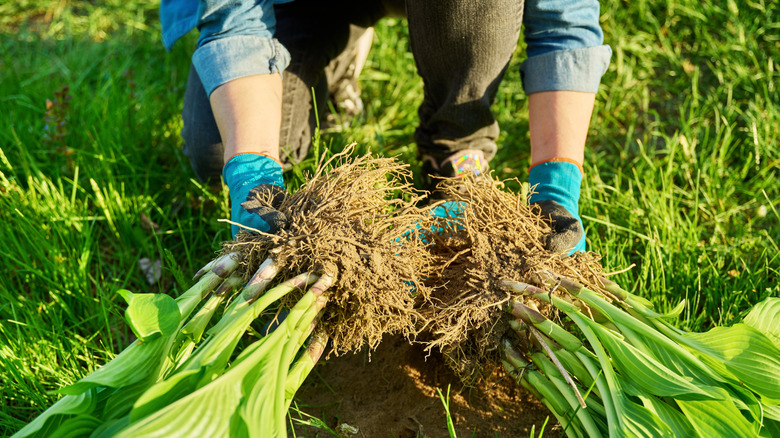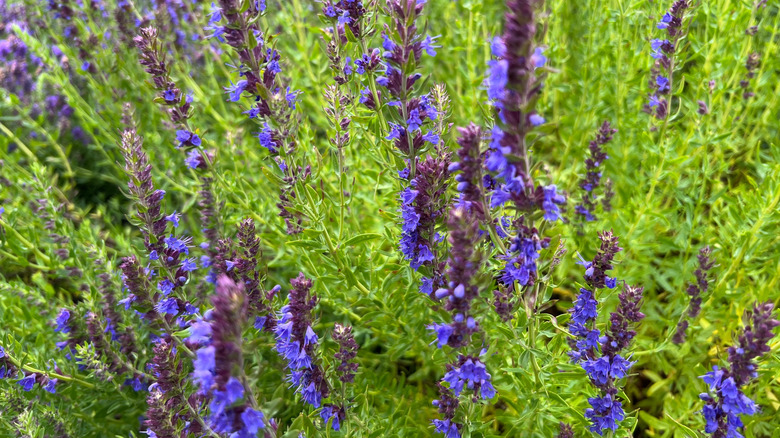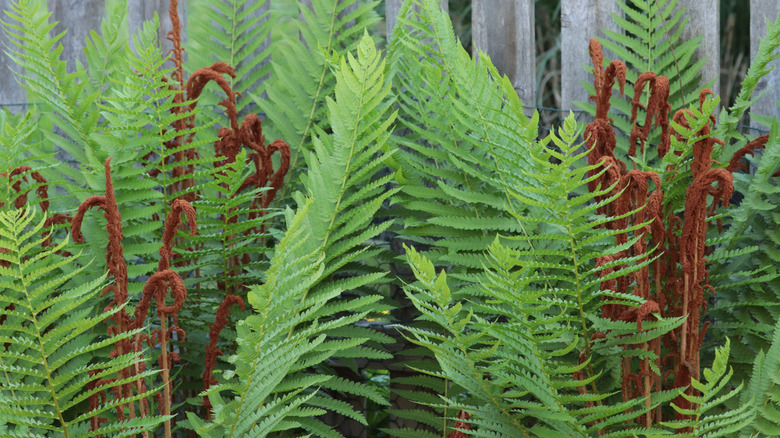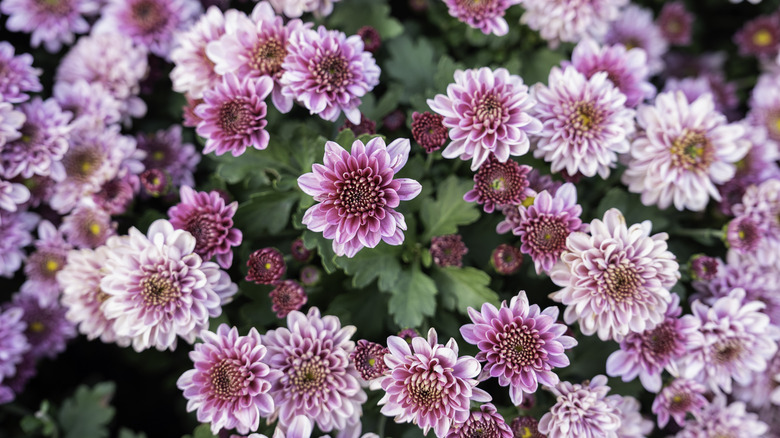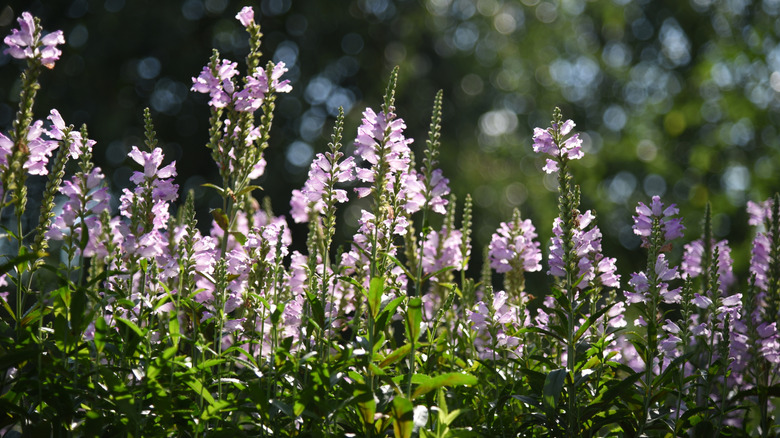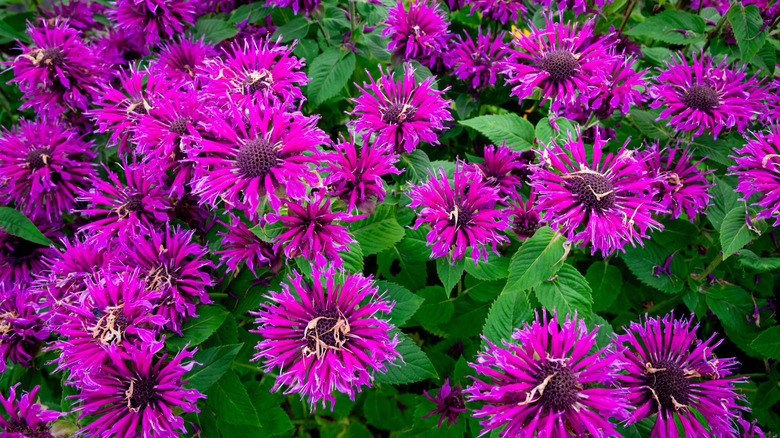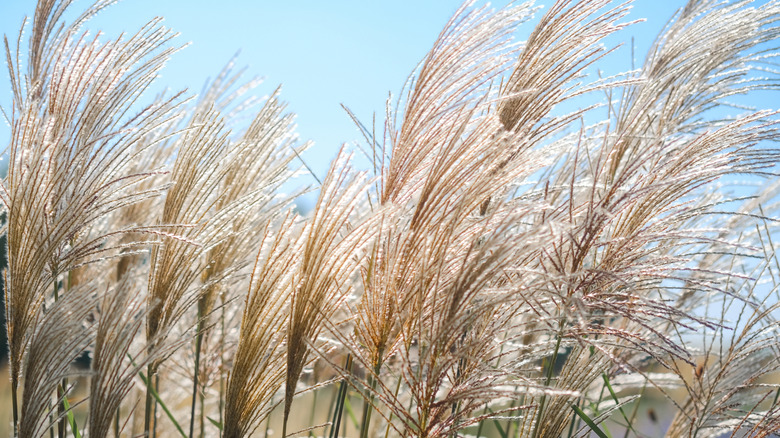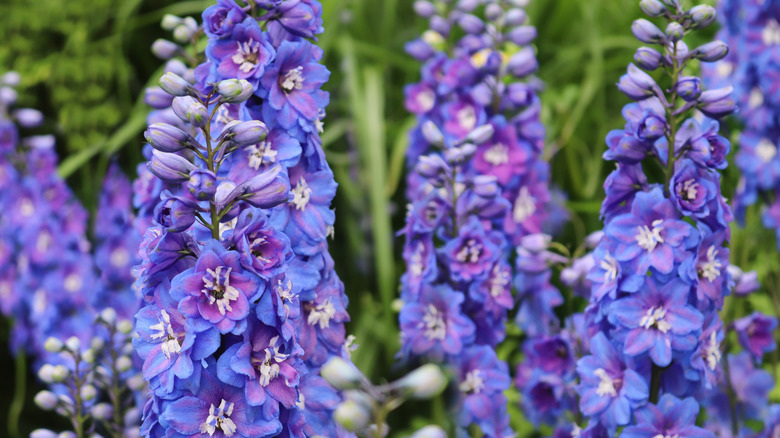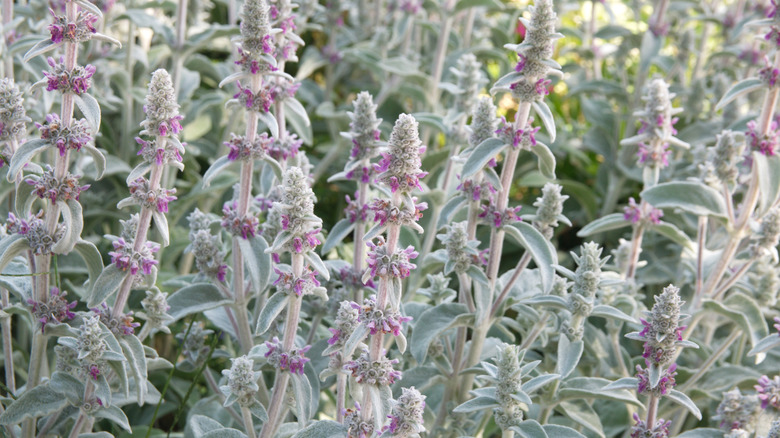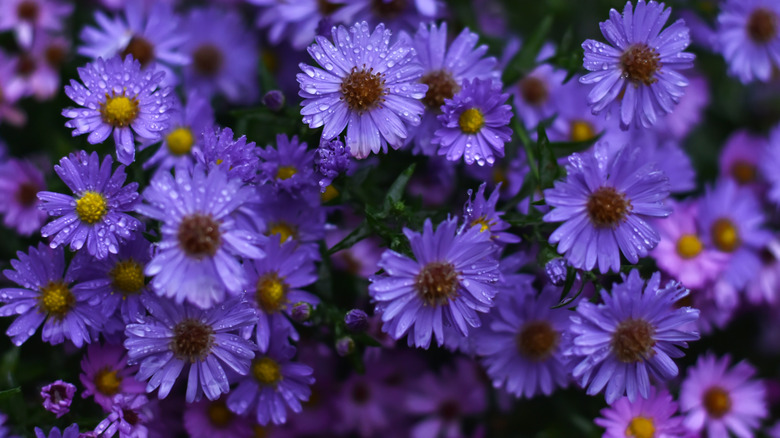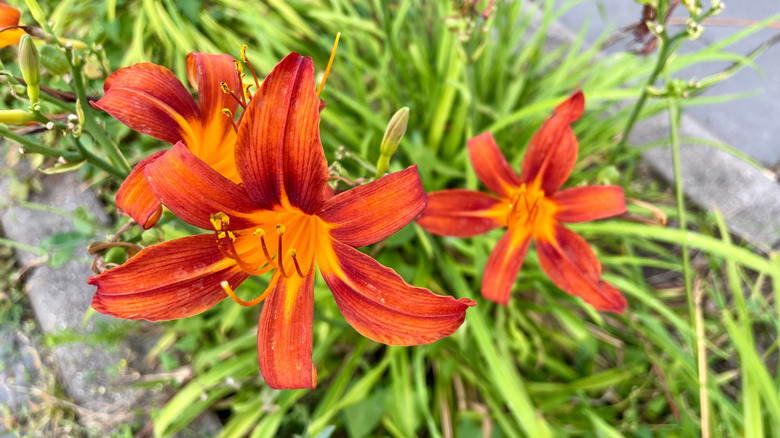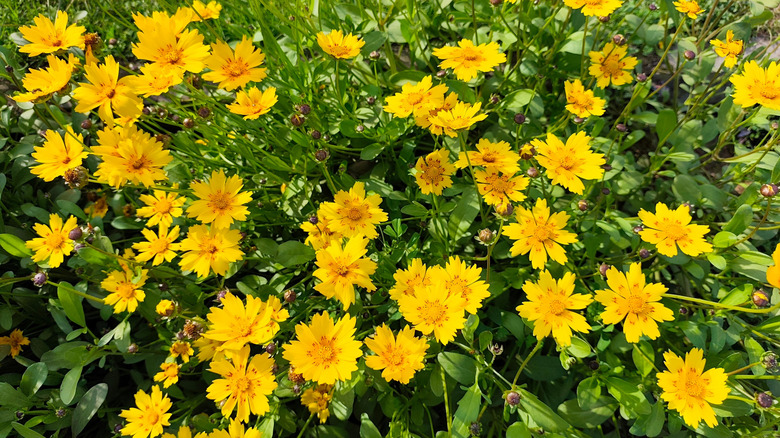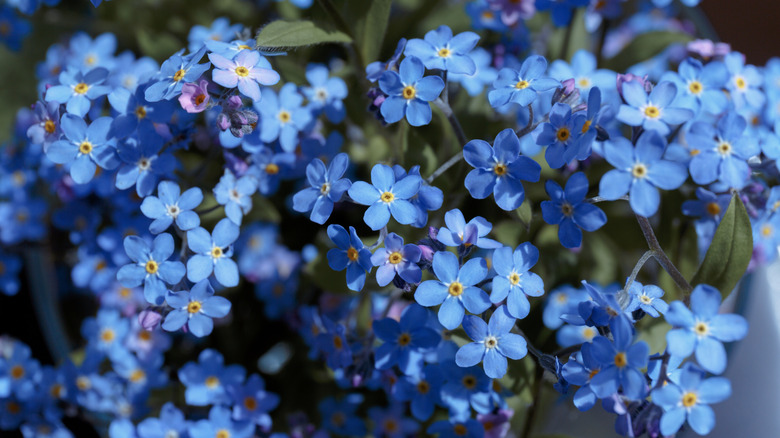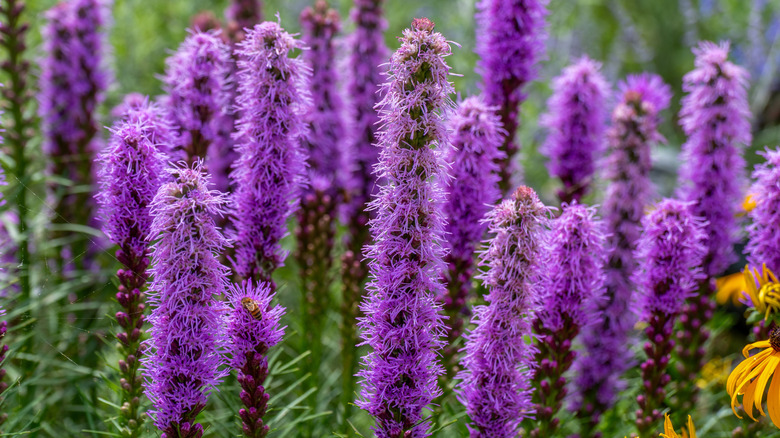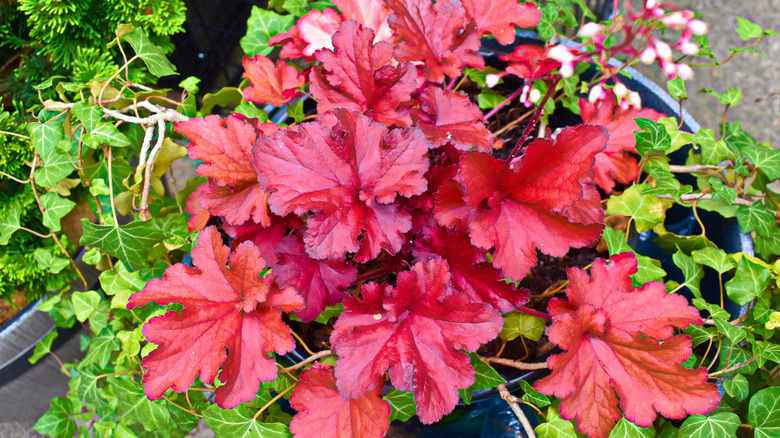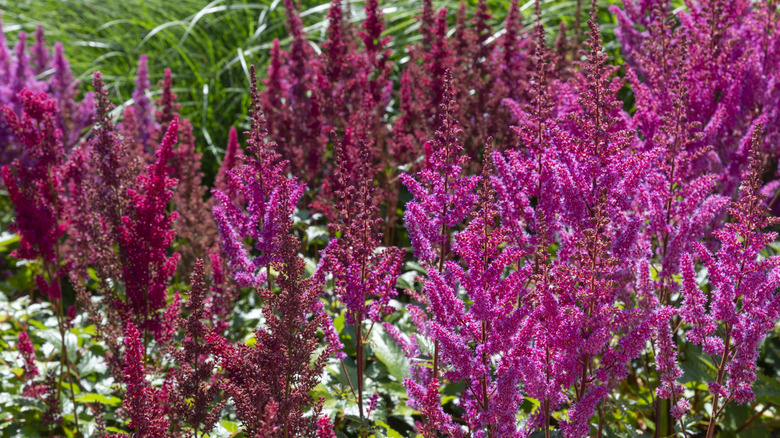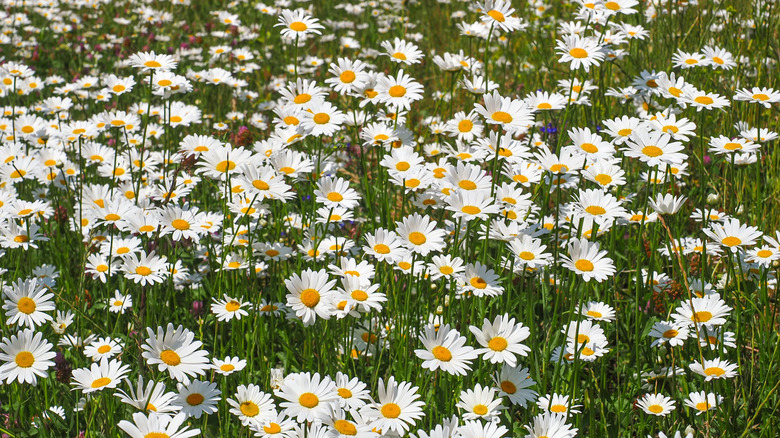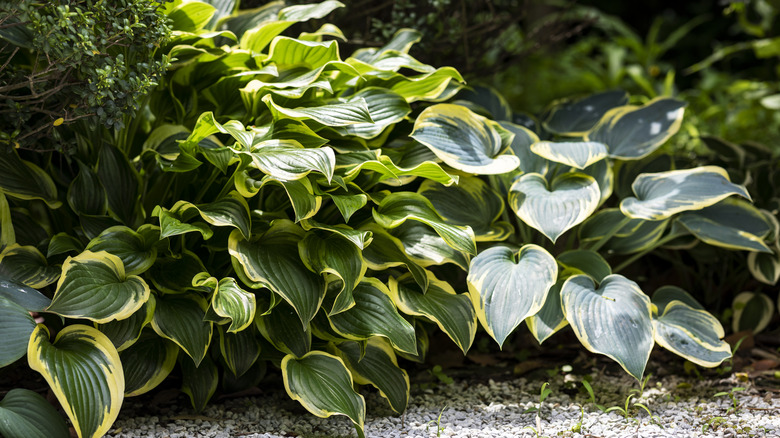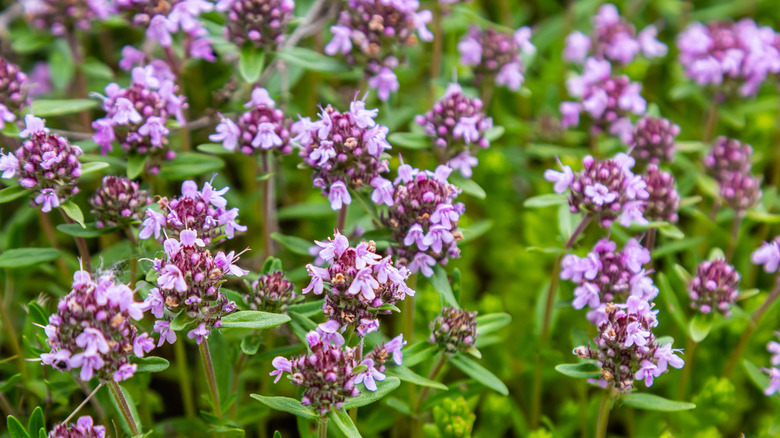Forgetting To Divide These 24 Perennial Plants In Spring Is A Mistake
We may receive a commission on purchases made from links.
It's funny how, on the one hand, you can't wait for the spring to fox-trot in and relieve you from the wintry drab. But once it does, the relief is quickly overcome by a feeling of overwhelm. After all, there are weeds to pull, beds to prepare, and plants to prune to keep them happy and healthy. To top it all, you must also divide certain perennials — bee balm, catmint, ferns, hyssop, sedum, and mums, to name a few — lest they overflow into each other, congesting and choking the garden beds.
Spring is a good time for dividing mid-summer and fall-blooming perennials because they're still dormant or, at most, putting out small leaves, making it easier to make cuts. Besides, the new divisions get ample time to settle down over the summer, utilizing the food reserves stored in their roots and soil's moisture for recovery. Spring division is especially important in cold climates with short growing seasons, as fall-divided plants usually don't have sufficient time to establish themselves before the ground freezes.
Here's a tip for healthy plants: Watering them a day before division, unless it rains, eases digging. Preparing the site for new plants beforehand will prevent their roots from drying. Even if you aren't keeping the extra from your divisions, skipping this step can result in stunted growth in both leaves and blooms, dead cores, or poor form, so this process is worthwhile for rejuvenation — unless they belong to the tribe of perennials you should avoid dividing at all costs. You can probably find a grateful friend or family member to take the extras off your (dirty) hands.
Hyssop
Hyssop (Hyssopus officinalis) is a butterfly-friendly plant with medicinal properties you can grow in your garden. But, since it's a profuse self-seeder, consider deadheading the flowers — unless you want them popping up all over your yard — and annually propagate new plants through division, instead. As certain varieties tend to change their bloom color from blue to pink or white, dividing them now helps retain those lighter colors. Come spring, lift the plant and separate it along its woody roots. Replant the divided portions in well-draining soil and ensure they're spaced about 12 to 18 inches from each other.
Cinnamon fern
Due to their vigorous growth, cinnamon ferns (Osmundastrum cinnamomeum) are best divided every year. But if that feels excessive, be sure to tackle the task when their centers grow dead or hollow out, like a donut. Or, when you notice the new leaves being smaller than you're accustomed to, which usually happens in three to five years. Before the ferns leaf out in spring, undertake "edge division." In this method, you must spade the segments with roots intact from the clump's outer edge — not from the center.
Chrysanthemums
Chrysanthemums (Chrysanthemums x morifolium) tend to overcrowd their centers as they age, in turn, losing out on precious blooms. So, to keep them vigorous and bountiful, you should divide them every couple of years after the last spring frost. When their new growth is about 1 to 3 inches tall, dig out the whole clump and discard the old central core along with any diseased woody parts. Afterward, using a spade or a sharp knife, separate the tiny plants (with roots) growing around the core. Place the divisions in rich, fertile soil and keep it moist through the summer.
Obedient plant
While obedient plant (Physostegia virginiana) is obedient about retaining the shape its blooms were strongarmed into, it behaves oppositely when it comes to respecting boundaries. Because of its rapid growth rate, it takes over garden beds in a couple of years — especially in moist soils — outcompeting the surrounding vegetation. That's why, to keep their spread in check, you must divide obedient plants annually or every other year. Luckily, as these deer-resistant perennials have shallow roots, they can be easily lifted out and separated. Give away the extra divisions or toss them into compost if space is limited.
Bee balm
Many gardeners grow bee balm (Monarda spp.) to feed monarch butterflies and hummingbirds, not to forget, native bees. But because they spread through rhizomes, bee balms can take over your garden unless divided every other year or three. Besides, separating their clumps helps bolster their growth. In early spring, ease the bee balm out. Using a sharp knife, slice the clump into different sections, ensuring they all receive a healthy set of roots and shoots. Dispose of the old central section because it isn't as vigorous, and plant the remaining segments immediately in moist, well-draining soil.
Northern maidenhair fern
Native to the eastern U.S., northern maidenhair fern (Adiantum pedatum) is mostly grown on moist, hilly sites or in deep shade, as an ornamental. Birds, too, quite like its fronds as nesting material. However, as maidenhair fern spreads slowly, taking several years to reach its characteristic saucer form, it's best to divide its clumps only as needed — especially when grown as a ground cover. Before the ferns wake up from dormancy and sprout new leaves in early spring, lift them out after clearing the dead foliage. Cut their creeping stems or rhizomes and replant slightly above ground level.
Warm-season ornamental grasses
Although warm-season ornamental grasses are usually low maintenance, after a couple of years, their central crowns start thinning or, worse, die out completely. So, to ensure they continue to render ornate value and remain a wieldy size, you should divide your ornamental grasses in spring. Before they leaf out, splice their clumps with a sharp knife into multiple sections after amputating the core. For overgrown grasses or plants with dense roots, use an ax or a hatchet instead. Alternatively, you may chop them into quarters with a digging spade and replant immediately to prevent the roots from drying.
Delphinium
Unless grown as an annual or biennial, you can divide delphinium in early spring. As most varieties are short-lived, separating their clumps and replanting can help extend their life and encourage new growth. It's also a nifty way to reduce the existing plant size, while simultaneously producing more plants. After digging out your plant, examine the root crown for obvious division sites and knife them through along with a heady chunk of the root system. Get rid of the older stems and replant the divisions. Depending on your plant's health, undertake this activity every one to three years.
Yarrow
Either to revitalize old growth, control their spread, or get new plants to cover your landscape, you might need to divide yarrow (Achillea spp.) every year — or up to every three years — when its central parts begin dying with age. Separate the clumps in spring when they're still dormant. After casting off the woody core, splice their mass in half with a spade or knife. You can create more divisions if your plant is especially overgrown. Space the new divisions about 12 to 18 inches away in well-draining soil, but make sure they lay slightly above soil level.
Lamb's ear
Lamb's ear (Stachys byzantine) throws out modified stems that root wherever they touch the soil, increasing their span. So, to prevent them from overcrowding the beds, consider dividing them every couple of years, or later when their cores die out. After winter, snip off and rake the dead foliage. Dig the plant out with a shovel while it's putting out new growth. Typically, the plant will divide itself along the modified stems with its roots intact, though you may splice the clump apart by pushing a spade in the middle of the coarse root mass for more divisions.
Aster
Another beautiful perennial that benefits from early spring division is aster. When left to its own devices, sans any division, it outstrips its cultivated boundaries by sending out runners, while gradually undergoing a decline in blooms. For these reasons, every second or third year you must dig the plant up as soon as it starts greening up. With the help of a sharp knife, cut up the clump into small divisions, making sure they all have abundant roots and at least three shoots. Get rid of any woody parts as well as weak centers.
Daylilies
Generations of gardeners have added daylilies (Hemerocallis spp.) — often as grandma's hand-me-downs — to their perennial borders. But once they outgrow their corner in three to five years, you must divide them; otherwise, they won't bloom as profusely. Early spring is ideal while they're greening up. Dig up the clump, rinse off the soil, and push two digging forks into the root crown. This method works better than a knife because daylilies have dense crowns. Pull the forks apart, making sure each divided portion has at least four leaves, a.k.a. fans. This may affect flowering in the current season.
Purple meadowrue
Prized for its bluish-green foliage and colorful cut flowers, purple meadowrue (Thalictrum dasycarpum) may require a brutal whack every three years, though you can delay it to after the fourth year. Otherwise, it may quit producing new flowers and languish in growth. In early spring when you're ready to work the ground, dig out the clump, as you must divide it while it's still dormant. Separate it along growth points, ensuring each divided section has healthy roots. Please note that divided plants may experience delayed growth as they tend to grow at a snail's pace.
Tickseed
Dividing tickseed (Coreopsis spp.) provides three major benefits: improved plant vigor, better cold hardiness, and extended life (especially for C. lanceolata and C. grandiflora). In addition, it prevents the mature plants from spreading their runners in unwelcome spaces, contending with the abutting ornamentals. When tickseeds develop green leaves in early spring, dig them out of the soil. With a spade, slice their root crown and rhizomes into multiple divisions after removing the dead core. Don't leave the plants undivided for more than three years, or you might compromise their performance.
Catmint
Catmint (Nepeta spp.) is stupendous at deterring rodents with its minty aroma, but it must be divided every three to four years for the benefits to continue. Catmints are quick to overcrowd the beds and become weedy. This lowers their blooming potential while simultaneously turning them into hotbeds for diseases because of the limited air circulation. To avoid such a fate, either early in spring or after the first flush, dig out the catmint. Splice its clump into four segments or more, so long each segment has a sizable number of healthy roots and young shoots. Water well until establishment.
Forget-me-not
Don't forget to divide forget-me-not (Myosotis spp.) in early spring. Or, you would wound up with a plant that doesn't bloom well or looks woody. Luckily, you don't need any fancy tools to separate the clumps. Every third or fifth year, prod the perennial out of the soil and pull it apart with your hand, divvying it into smaller sections. Plant the divided segments immediately and water soundly until they're fully established. That being said, please note that certain myosotis varieties are invasive in some U.S. states. So, check with your state extension before dividing, lest you need to remove them.
Blazing star
While you can save seeds from blazing star (Liatris spicata) for propagation, dividing its tuberous roots, a.k.a. corms, helps ensure the plant is truer to the parent. Moreover, unlike seeds, which may take an additional year to bloom, corm-grown plants flower in the same planting year. When the clump begins to produce new growth, dig it up and separate the corms using a sharp knife. Make sure each segment has at least one eye. You may need a shovel for denser roots. In addition to propagation, division is essential for rejuvenating the plants and should be carried out every three to five years.
Coral bells
Coral bells (Heuchera spp.) have a lot of positive attributes: they attract hummingbirds, swath the ground with colorful foliage, and bloom pretty flowers throughout summer. Unfortunately, they don't live for long, which is why dividing them intermittently — about every three to four years becomes necessary. When it's early in the spring season, heave out the clump with a digging fork. Remove the old central crown and separate the healthy plant parts, the ones with tiny leaves, into divisions with a sharp knife. Apply rooting hormone to the divisions before planting in a sunny or partially shaded site.
Sedum
Sedum (Hylotelephium), including the ever-so-popular cultivar 'Autumn Joy,' should be divided in early spring. Since it usually suffers winter die-back, waiting until spring when the plant starts to leaf out helps pinpoint its presence. Besides, division every three to four years will help rejuvenate your plant, restoring its vigor and blooming potential, while keeping its size in check. Simply nudge out the sedum from the ground with a spade. Next, split the clump into multiple sections, provided they all receive a good portion of healthy roots and shoots. Nestle the divided parts in a sunny site containing fine-draining soils.
Astilbe
To promote better blooms, divide astilbe every three years or later when it grows lackadaisical. In case you left the foliage standing for winter protection, tidy it up when it's spring but before the onset of new growth. Later, haul up the perennial to reveal its root neck. Either shake it or hose it with water to loosen the soil. Knife the plant crown in its center for division, making sure both parts have about four live buds. When replanting, lay the cut sections even with their original height. Site them in dappled shade, mulch their roots, and water judiciously until establishment.
Shasta daisy
Imagine growing the best varieties of Shasta daisies to enjoy colorful blooms all summer long, only for them to turn unproductive and not look their best in a few years. To avoid such an outcome, divide Shasta daisies (Leucanthemum x superbum) periodically — at least every 3 years or less — so they may remain vigorous, yet limited to their bounds. This will also help prolong their short lives. Simply pry the plant out of the ground, knock off the soil from the roots and detangle them. After removing the oldest core, separate the healthy root mass into four or more divisions.
Hosta
When hosta plants hit age five, their centers start thinning or hollowing out, making them unsightly. Under such circumstances, dividing them in spring when their new leaves are just 1 to 2 inches tall can restore vigorous growth. Any later and the plant will grow lopsided in the summer heat. Since their roots are densely packed, you'll need to pry them loose with digging forks (as you did for daylilies) or a heavy knife. Each division can yield up to six new plants, though they won't flower for the next two years.
Thyme
Italian cuisine's staple, thyme, will also benefit from division, as it not only encourages better growth but also improves its taste. When the herb grows beyond its ordained boundaries or develops a hollow core — usually in a couple of years or more — know it's time to separate the perennial. When it's early in spring and thyme has yet to flower, prod the mound out with its root ball. Remove the dead woody core and then, use a spade to cut through the mass for two or more divisions. Plant the separated parts in their chosen site and water well.
Lady's mantle
Unless you live in Oregon, where lady's mantle (Alchemilla mollis) is invasive and accordingly must be destroyed, consider separating it in early spring every six to 10 years. However, if you miss the bus, you can reliably divide it throughout the growing season. As for the specifics, after lifting out the perennial, split its root ball into three sections if they all have healthy, leafy shoots. For older plants, you can make more divisions. Pop them in the garden at the original depth and continue watering the divisions until they quit looking flaccid (in other words, have established successfully).
